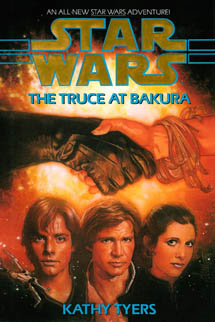“Shadows of the Empire,” which I recently reviewed, leads directly into “Return of the Jedi,” and “The Truce at Bakura” (1994) leads directly out of “Jedi.” For that reason alone, it should be an intriguing novel to “Star Wars” bookworms.
It was also an odd novel at the time of its publication, because author Kathy Tyers’ inclusion of the alien Ssi-Ruuk placed “Bakura” more firmly in the sci-fi mold than previous books, with the possible exception of L. Neil Smith’s “Lando Calrissian” trilogy. In a twist on a familiar genre trope, the Ssi-Ruuk use machines to strip the life presences from humans in order to power their battle droids, and they see the capture of Luke — and his powerful life presence — as the key to galactic takeover. Tyers also peppers some horror into “Star Wars” with her gruesome description of the heart-targeting larvae that Luke is infected with by Imperial Governor Nereus.
Sci-fi elements, horror and alien invasions would become common in the years that followed. In fact, the “New Jedi Order” series’ Yuuzhan Vong invasion was essentially the “Bakura” plot stretched over 19 novels. And Bantam hired many more sci-fi authors to dabble in “Star Wars” throughout the 1990s. Still, it was the unusual-at-the-time elements that I remembered going into my re-read of “Bakura.”
Coming out of it, I’m impressed that Tyers really digs into the characters’ reactions to the events of “Jedi.” Leia harbors an unforgiving hatred of Darth Vader, who appears to her in a vision as Anakin Skywalker, and she even argues with Luke about their father’s galactic legacy. (Although it doesn’t seem in character for Anakin to ask forgiveness of Leia — I’d think he’d be more self-loathing, even as a ghost — Tyers does foresee the 2004 DVD Special Edition by having Anakin appear in his younger form.) Also, Han and Leia have relationship struggles (although it’s clear they love each other), and Luke deals with the physical pain of the Emperor’s lightning attack.
Although Timothy Zahn brought politics into “Star Wars” with the Thrawn trilogy, “Bakura” feels more like George Lucas’ prequels in that Tyers tells a lot of the story through the political arena, rather than action scenes. The Bakuran people’s revolt against their Imperial masters happens “off-screen” the same way the Naboo concentration camps did. Tyers lays out quite clearly what the Alliance and the Empire each stand for. Although Nereus is a typical villain, the author provides some nuance with Commander Thanas, who questions whether he’s on the right side, as does Gaeriel Captison, a potential love interest for Luke.
Considering that she often makes top-4 lists of Luke’s most famous girlfriends (behind Mara, Callista and Shira), her connection to Luke is tentative and chaste. Gaeriel objects to Jedi on religious grounds and to the Rebellion because she’s grown up in Imperial schools. She’s a bit of a shallow character and one might wonder what Luke sees in her. (At this point in the saga, perhaps, Gaeriel stands out to Luke by being an attractive young female who’s not his sister.)

Tyers nails the characterizations of the main six (no Lando in this book). C-3PO, who openly insults his human masters at some points, comes off much brasher than in most novels. However, he’s more in line with his portrayal in the films (recall 3PO insulting Chewbacca when in disrepair), and arguably Tyers does a better job with the character than most novelists.
From the nitpick category, Tyers gets some terminology “wrong,” such as using the word “Standard” instead of “Basic.” It’s not actually her fault, as this book was published before Lucasfilm had really started paying attention to that stuff. (And, truthfully, it’s kind of fun to find such “flaws” in older novels.)
This is still a middle-of-the-road “Star Wars” novel, but it probably gets a worse rap than it deserves since it was the first hardcover published after the Thrawn trilogy. While it’s not as essential to galactic lore as those books or “Shadows of the Empire,” it’s a worthy portrayal of what the characters are going through immediately after “Return of the Jedi.” If you’re doing a “Jedi” re-watch for the 30th anniversary, it might be fun to follow it with a re-read of “The Truce at Bakura.”

